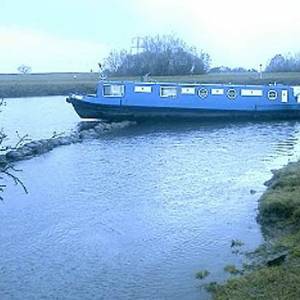
Notorious submerged wall catches another boater out on the River Trent
A 57ft narrow boat and its crew left Torksey lock to travel to Newark, however shortly after leaving Torksey, disaster struck and the crew found the engine lacked power. As a result they were not making headway but luckily a fellow boat managed to tow them to the pontoons at Dunham Br. After taking a break they decided to carry on and, having passed under the A57 bridge, they headed to a tight ‘s’ bend in the river. The boat navigated the first right hand bend successfully but as they reached the second bend they lost drive again and suddenly found themselves grounded.
They were in relatively deep water and there were no signs of an obstruction but try as they might they were wedged tightly and could not escape…. It was at this point that the engine cut out and they could not re start it. As time went by they realised that the tide was going out leaving them even more stranded on the unknown obstacle. The captain contacted BW Waterways] who, after some discussion, agreed to send out a tug to assist them. Unfortunately with the tide going out it was not going to be easy and with the tide only due to turn at 8pm could have been a long and dangerous wait.
The captain then contacted RCR (the AA of waterways) to see if they could send an engineer out to get the engine running. RCR received a call at approximately 11.30am, and although they offer a Join on The Spot membership this option was not available because the boat was inaccessible. RCR have a fully trained rescue team trained by the RLNI to undertake water rescues; as in the past they have had to rescue a number of boats in precarious situations on the river Trent.
The captain was offered the option of the rescue team attending, and the potential scenarios that might occur, including possible capsizing of the vessel and the need to get the captain and crew off the vessel whist the engineers attended to the engine.
Working on a river is dangerous and combining this with freeing a vessel as the tide rises can put lives and boats at risk. RCR dispatched their rescue team of three personnel (K.Horton, P.Barnet, & T.Forman) to undertaken the rescue of the boat. They were equipped with a small rib, to get to the vessel, and essential safety equipment to ensure minimal risk to personnel.
The tide was dropping rapidly so the aim was to get a rescue boat in the water as soon as possible so that the engineers could get aboard the narrowboat and assess the situation. The engineers arrived on site at 1.30pm.
Having attended three previous rescues in this particular location the engineers were confident that the obstacle that had grounded the vessel would be a stone wall which extends in to the Trent on the bend. The wall is present to reduce bank corrosion but, as it is unmarked it presents a serious obstacle if a boater decides to cut a corner. The engineers launched the vessel at Dunham Bridge and set off to locate the stranded vessel.
When the engineers arrived at the vessel it was clear that there would be no possibility of towing the boat off the wall and although there was no immanent danger to the crew the decision was taken to get them off the vessel to ensure their safely and allow the engineers to work on the engine without any distractions. The BW tug arrived on the scene at approx 2.15pm, but with no possibility of pulling the boat without damage they moored up at the pontoons and waited to see if they were needed once the tide started to rise.
The engineers worked for 4 hours to get the engine running, removing several litres of water from the fuel tank, and fitting a new fuel pump which had also failed. The fuel tank was treated with Marine 16 additive to remove any additional water and also kill any diesel bug that might be developing. Finally at 6pm the engine was successfully started. Unfortunately with the boat completely stranded the only thing everyone could do was wait for the tide to turn at 8pm.
At approximate 8.30pm the decision was taken to use the BW tug to pull the boat free rather than waiting for the tide to rise high enough to re-float. The BW crew executed this with obvious experience and once free of the wall the engine was fired up and the boat turned and cruised up to the pontoons to be reunited with its owners. The engineers loaded up the rescue boat and finally headed home after a job well done

